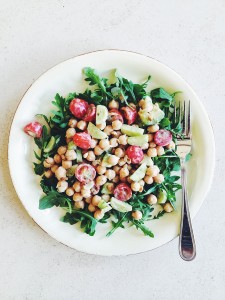Easy tips to help students stay healthy during exams
For many college students, finals week is synonymous with countless hours of studying, sleepless nights and unhealthy eating patterns. What caffeinated beverages and junk food lack in nutritional value, they make up for in quick jolts of energy. It can be difficult to prioritize eating well through this particularly stressful period of the semester. Through personal experience, I have discovered a few simple tips and techniques to stay healthy amid the stress. Making minor yet mindful changes to your routine will improve your overall mood and energy level, helping you feel prepared and confident on exam day.

A healthy alternative · Tomato and chickpea salad with yogurt dressing is a perfect example of a substantial salad that can provide vegetables and lean proteins as an alternative to fatty foods while facing off with an exam. – Maral Tavitian | Daily Trojan
Start with a solid breakfast
Skipping the first meal of the day is one of the worst decisions a college student can make during finals week. Eating a hearty, well-balanced breakfast not only gives you the energy to start the morning off right, but also helps reduce unnecessary snacking throughout the day. Protein-rich foods such as eggs and Greek yogurt are reliable and versatile options. With minimal effort, both of these staple ingredients can be quickly transformed into a satisfying meal. If you are in the mood for something sweet, mix yogurt with nut butter, fresh fruit and a sprinkle of muesli or granola. I often pack this breakfast in a jar in the evenings, allowing me to throw it in my bag when I leave for class.
Though even novice cooks can scramble eggs, mixing in a handful of diced vegetables, leafy greens and grated cheese instantly transforms the old standard. These ingredients not only add fresh flavor and color to the scramble, but they also increase its volume, making you feel more satisfied.
Look for substantial salads
Most college students indulge in fatty foods during times of stress, but a hefty salad consisting of grains, vegetables and lean proteins can be surprisingly satisfying. Even though these substantial salads require a few different ingredients, they are quite simple to prepare given a well-stocked refrigerator. To keep each bite interesting, it is important to maintain a balance of flavors and textures. Raw greens and vegetables serve as the base, while sliced avocado and a fried egg provide richness, and garnishes such as toasted nuts and dried fruit add crunch.
There really is no right way to assemble a salad; feel free to get creative and tweak the flavors according to your tastes. For inspiration, look no further than my tomato and chickpea salad with yogurt dressing. The cool yogurt dressing perfectly complements the peppery arugula and toasted pine nuts. A fried egg, with its crisp, lacy edges and signature runny yolk, binds the dish together into a cohesive whole.
Snack with discretion
While snacking helps students persevere through arduous study sessions, overeating out of boredom can quickly become a dangerous habit. Dividing snacks into individual portions is an easy yet impactful way to control the amount you consume. Rather than munch on trail mix or pretzels directly from the bag, distribute single servings into separate containers. Doing so helps you visualize exactly how much you snack on in a given day, and understand appropriate portion sizes. If you have an insatiable sweet tooth, try creating a rewards system for chocolatey treats. Your productivity may increase knowing that a piece of dark chocolate is waiting for you after you finish writing a page of your research paper. Though these recommendations are useful to keep in mind, avoiding impulsive snacking entirely is the ideal solution. To reset your focus during a long night of studying, take a short walk around campus or read an article from a favorite magazine. Ultimately, you will feel proud of yourself for resisting the urge to eat out of stress.
Tomato and Chickpea Salad with Yogurt Dressing
• 1 15 oz. can of cooked chickpeas
• 1 cup of cherry tomatoes, sliced crosswise
• ½ cup of cucumber slices (from about 2 medium cucumbers)
• ½ avocado, cubed
• 2 tablespoons pine nuts, toasted
• 2 cups arugula
• ¼ cup plain yogurt
• 2 teaspoons olive oil
• 1 teaspoon lemon juice
• 2 large eggs
• Salt and pepper, to taste
Total: 15 min. Serves 2.
1. Rinse and drain the chickpeas and thoroughly pat dry with paper towels. In a medium bowl, mix together tomatoes, cucumber, avocado, chickpeas and pine nuts. Season to taste with salt and pepper.
2. To make the dressing, combine yogurt, olive oil and lemon juice in a small bowl. Season to taste with salt and pepper. Pour the dressing over the chickpea mixture in tablespoons, mixing just until the chickpea mixture is coated. Set aside.
3. Heat a medium skillet over medium-high heat. Spray with non-stick cooking spray or coat with olive oil. Once the oil is hot, crack the eggs into the pan, season with salt and pepper and cook for 3-4 minutes, until the edges are browned and crisp but the yolk is runny. To serve, place one cup of arugula on each plate. Divide the chickpea mixture evenly between the two plates and top with the fried egg.
Maral Tavitian is a sophomore majoring in print and digital journalism. Her column, “The Epicurean Dorm,” runs Tuesdays.

